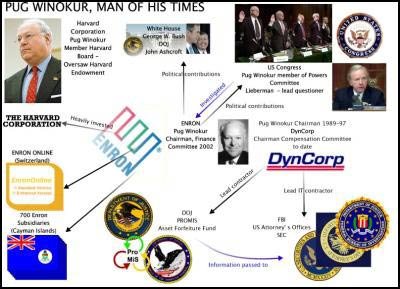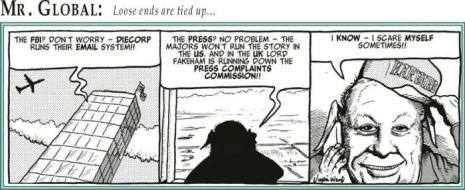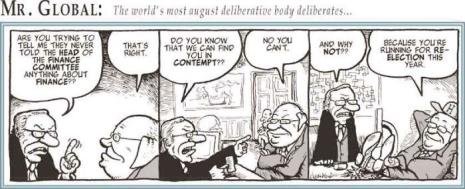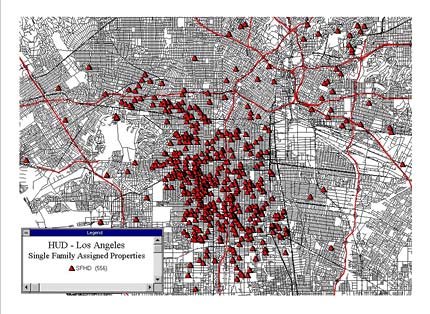


Dillon, Read & Co. Inc. and the Aristocracy of Prison Profits: Part VI
A Financial Coup d’État, the Role of Private Banking, and Closing Thoughts
By Catherine Austin Fitts
A Six-Part Series for The Narco News Bulletin
March 14, 2006
This is Part VI of Catherine Austin Fitts’ six-part series on the hidden system of money laundering, drug trafficking and rigged stock market riches inside the financial world, government agencies and their private contractors. To read the introduction and Part I of this series, with a table of contents linking to other installments, click here.
Financial Coup d’État 1998
The Hamilton Securities Group had a subsidiary charged with taking our data as it developed on individual transactions and portfolio strategy assignments and using it to develop a new approach to investment. We sought to help investors understand the impact of their investments on people and places and on a wider society as a strategy to identify opportunities to lower risks and enhance investment returns.[1] This included understanding how to reduce the dependencies of municipalities and small business and farming on debt and increase their ability to finance with equity. Indeed, easy, subsidized access to equity financing is one of the reasons that large companies have grown so powerful and taken over so much market share from small businesses. Access to equity investment for small business and farms would result in a much healthier economy and much more broad-based support for democratic institutions.
We were blessed with an advisory board of very capable and committed pension fund leaders. In April 1997, we had an advisory board meeting at Safeguard Scientifics where the board chair led a venture capital effort. I gave a presentation on the extraordinary waste in the federal budget. As an example, we demonstrated why we estimated that the prior year’s federal investment in the Philadelphia, Pennsylvania area had a negative return on investment. It was, however, possible to finance places with equity and then reengineer the government investment to a positive return and, as a result, generate significant capital gains. Hence, it was possible to use U.S. pension funds to increase retirees’ retirement security significantly by investing in American communities, small business and farms all in a manner that would reduce debt and improve skills and job creation. This was important as one of the chief financial concerns in America at that time was ensuring that our retirement plans performed financially to a standard that would meet the needs of beneficiaries and retirees. It was also critical to reduce debt and create new jobs as we continued to move manufacturing and other employment abroad. If not, we would be using our workforce’s retirement savings to finance moving their jobs and their children’s jobs abroad.
The response from the pension fund investors was quite positive until the President of the CalPers pension fund the largest in the country said, “You don’t understand. It’s too late. They have given up on the country. They are moving all the money out in the fall (of 1997). They are moving it to Asia.” He did not say who “they” were but did indicate that it was urgent that I see Nick Brady as if our data that indicated that there was hope for the country might make a difference. I thought at the time that he meant that the pension funds and other institutional investors would be shifting a much higher portion of their investment portfolios to emerging markets. I was naïve. He was referring to something much more significant.
The federal fiscal year starts on October 1st of each year. Typically the appropriation committees in the House and Senate vote out their recommendations during the summer. When they return from vacation after Labor Day, the various committees reconcile and a final bill is based in September. Reconciling all the various issues is a bit like pushing a pig through a snake. Finalizing the budget each fall can make for a tense time. When the new bill goes into effect, new policies start to emerge as the money to back them starts to flow. October 1st is always a time of new shifts and beginnings. In October 1997, the federal fiscal year started. It was the beginning of at least $4 trillion going missing from federal government agency accounts between October 1997 and September 2001. The lion’s share of the missing money disappeared from the Department of Defense accounts. HUD also had significant amounts missing. According to HUD OIG reports, HUD had “undocumentable adjustments” of $17 billion in fiscal year 1998, and $59 billion in 1999. The HUD OIG refused to finalize audited financial statements in fiscal year 1999, refused to find out the basis of the undocumentable adjustments or to get the money back and refused to disclose the amount of undocumentable adjustments in subsequent fiscal years.[2] The HUD OIG continued to invest significant resources in persecuting Hamilton during this time.
The contractor who was blamed for the missing money at HUD was a financial software company named AMS. My old partner, Steve Fenster, the Dillon Read banker who led the firms effort in the Campeau leveraged buyout of the Federated Department Stores which had gone bankrupt (See my description expressing my concerns to Steve regarding this deal in “A Parting of the Ways” earlier in this story), had been a board member of AMS until his death in 1995, when he was replaced by Walker Lewis, a board member affiliated with Dillon Read and now, as Chairman of Devon Value Advisors, a consulting partner to Pug Winokur and Capricorn Holdings. With $17 billion and $59 billion missing from HUD, Secretary Cuomo never fired AMS or seized their money. Indeed the AMS Chairman Charles Rossotti was appointed IRS Commissioner and given a special waiver to keep his AMS stock. As a result, he profited personally when HUD kept AMS on its contractor payroll and new task orders were awarded to AMS by the IRS. As IRS Commissioner, he oversaw the responsibilities of the IRS criminal investigation division that plays a special role with respect to money laundering enforcement during the period when $4 trillion went missing from the Federal government. When Rossotti left government service, he joined Lou Gerstner at The Carlyle Group.
If we assume that the $17 billion went missing at HUD during 1998 on an even basis that is, $1.4 billion a month, $63.6 million per week day, $7.9 million per working hour by the summer of 1998, approximately $14 billion would have been missing from HUD alone, not counting other agencies. Where did it go? Was it financed with securities fraud using Ginnie Mae or other mortgage securities fraud or fraudulently issued U.S. Treasury securities? These are important questions. Interestingly, this was also a period in which some of the most powerful firms in Washington, D.C. or with Washington ties were having remarkably good luck raising capital. Indeed, the period of missing money coincided, not surprisingly with a “pump and dump” of the U.S. stock market and a significant flow of money into private investors hands.
| Pump and Dump Adapted from Wikipedia, the free encyclopedia. The financial fraud known as “pump and dump” involves artificially inflating the price of a stock or other security through promotion, in order to sell at the inflated price. This practice is illegal under securities law, yet it is particularly common. One example of a highly successful pump-and-dump operator is Jonathan Lebed. Lebed was 15 years old when the SEC accused him of manipulating several securities — he settled the charges by paying a fraction of his total gains. While Lebed has many apologists, who note that his promotional activities are similar to those used by analysts every day, they fail to take into account that he not only made false and misleading statements about companies, but purchased enough shares to temporarily move the market, creating an artificial burst of activity that provoked investor interest. In fiction, a good example of how this works can be seen in the movie Boiler Room. |
In the summer of 1998, Carlyle Group announced that it had closed its European Fund with $1.1 billion. By the end of the decade Carlyle had more than a dozen funds with close to $10 billion under management. In the meantime Enron, transacting with Wall Street, was enjoying a rush of good luck with offshore partnerships and growing revenues from “the new economy.” Enron’s leaders included a “Who’s Who” of government contracting. Pug Winokur was the chairman of the Enron finance committee. Pug was also an investor and board member in DynCorp, who was running critical and highly sensitive information systems for DOJ, HUD, HUD OIG and the SEC. Arthur Anderson, Enron & DynCorp’s auditor, (also Cornell Correction’s auditor) was a major contractor at HUD. Frank Savage, a board member of Lockheed Martin, the largest defense contractor at the time paid more than $150 million a year to run the HUD information systems, was also on Enron’s board and finance committee. Enron and HUD shared all the same big banks Citibank, JP Morgan-Chase and Wall Street firms. Winokur was on the board and invested with the Harvard endowment, a large investor in Enron. The attorney representing his firm on SEC documents, O’Melveny and Myers, a prominent Los Angeles firm, was reported to be the lead firm helping Al Gore during the 2000 election. Harvard University was a HUD contractor and major source of HUD, Treasury and White House officials. The Harvard Endowment was a major investor in HUD real estate and mortgage operations along with Pug Winokur and his investment company. Harvard employees were one of the largest groups of lifetime contributors to Bill Clinton. Harvard was also a source of appointees for OMB, DOJ, SEC, DOD and other agencies through out the government.[3]
 Graphic: Sanders Research Group, republished from Scoop Media |
To repeat a critical point made earlier in our initial discussion of the leveraged buyout business that has engineered a take over of America’s economy money is like the Pillsbury Doughboy. When you squeeze down on one part it pops up someplace else. While we do not yet know the truth of who now has $4 trillion (or some other very large actual amount of cash and/or fraudulently issued securities) of undocumentable transactions indicating extraordinary amounts missing from the U.S. government or trillions more that disappeared out of pension funds and retail investors stock holdings during this period, we do know who has growing financial resources. We also know the extent to which extraordinary enforcement resources were used to target many of the honest people.





On December 18, 1997, the CIA Inspector General delivered Volume I of their report to the Senate Select Committee on Intelligence regarding charges that the CIA was complicit in narcotics trafficking in South Central Los Angeles. Washington, D.C. ’s response was compatible with attracting the continued flow of an estimated $500 billion$1 trillion a year of money laundering into the U.S. financial system. Federal Reserve Chairman Alan Greenspan in January 1998 visited Los Angeles with Congresswoman Maxine Waters who had been a vocal critic of the government’s involvement in narcotics trafficking with news reports that he had pledged billions to come to her district. In February Al Gore announced that Water’s district in Los Angeles had been awarded Empowerment Zone status by HUD (under Secretary Cuomo’s leadership) and made eligible for $300 million in federal grants and tax benefits. At the same time, the existence of Hamilton’s software tools and databases would have posed a significant risk if my team and I had become aware of the “Dark Alliance” story. The fastest way to connect the dots would have been for me and my teammates to have looked at the maps of high HUD single family defaults contiguous to areas of significant narcotics trafficking that we had posted on the Internet and then use the Hamilton Securities software tools and databases to dig deeply into government financial flows in the same areas, including patterns of potential mortgage and mortgage securities fraud.
 The Map of South Central Los Angeles, California Map courtesy The Hamilton Securities Group |
The destruction of our software tools, databases and computer system was arranged by a series of events between late 1997 and early 1998 that was so orchestrated throughout government, media and members of the Council of Foreign Relations that I would never have believed it if I had not lived through it.[4] The Washington Post mysteriously killed a story about what was happening to The Hamilton Securities Group at the last minute just as they had done with the Mena story in 1995. Our errors and omission insurance carrier suddenly refused to pay our attorneys, who withdrew from representation of The Hamilton Securities Group.
 Hayes Farm, purchased by Catherine’s maternal grandparents on their honeymoon and passed down through the generations, has a panoramic view of Mt. Washington and the Presidential Range in the White Mountains of New Hampshire — but no electricity. Photos courtesy Catherine Austin Fitts |
Judge Sporkin ruled against us in our efforts to get HUD to pay us immediately monies owed for work performed and then, for no legitimate reason, authorized our digital records and papers to be seized. On March 8, 1998, a court representative with a team of HUD OIG and FBI investigators landed in our offices and took them over. All copies of all documents whether in our office or in our homes and personal possessions were turned over. We were not allowed to keep copies of anything. We had been ordered by HUD to wipe all HUD databases from our server most of which were available to the public by law and certify that they had been wiped clean. We were told we could get copies or excess items of what had been turned over back quickly. In fact, with the exception of one server and a few computers, it took many years to recover any of our files. By the time our most critical files were returned to our control, our most valuable software tools had “disappeared” while under court control.
We were later to discover that DOJ was using CACI as a litigation support contractor on our case. CACI was the leading supplier of Geographic Information Systems software and services to the U.S. government who later was in the headlines as a result of their connections to the prison at Abu Grahbi in Iraq. This begs the question whether DOJ was paying our competitor to help themselves to our proprietary software and databases. Some time after our entire digital infrastructure was taken over, DOJ came out with a geographic information systems mapping tool to help support increased community policing and enforcement product. You had to wonder if this was the “Sheriff of Nottingham’s” answer to Community Wizard rather than using software to allow citizens to understand what government was doing, why not use software to provide increased surveillance of citizens by government.
While in possession of our offices, the HUD OIG investigators took empty shredding bins, filled them up with trash and then from a separate floor found and added corporate accounting files and then staged photo-taking by the HUD IG General Counsel, Judith Hetherton, who then sent us a letter alleging obstruction of justice as evidenced by our “throwing out” corporate accounting records. We were saved by a property manager who witnessed this charade and decided to help us out after he saw the intentional and very disgusting trashing of the The Hamilton Securities Group offices and was touched by our efforts to clean it up. The property manager had come to the U.S. from Latin Americapresumably to find freedom from lawless government. One of our attorneys went into the office when the federal investigators were there and came out shaking. He said to me, “My parents left Germany to get away from these people. Now they are here. Where do I go?”
Meanwhile, as soon as The Hamilton Securities Group’s digital and paper records and tools were under court control, computers auctioned off and websites taken down, Congress held surprise hearings on March 16, 1998 on Volume I of the CIA Inspector General’s Report on Gary Webb’s “Dark Alliance” allegations about government involvement in cocaine trafficking. The CIA Inspector General during these hearings disclosed the existence of the Memorandum of Understanding between the CIA and DOJ that had been created in 1982. Sporkin, the judge who had just engineered the destruction of Community Wizard and our digital infrastructure and had the carcass under his control, was the CIA General Counsel when that MOU was engineered.
There was one small glitch. When we were next allowed in our offices one evening in mid-March, we took the main server and brought it back to my home. The next day, a HUD auditor was stunned to see it gone he assumed that everything would be wiped clean and sold. He asked where the server was and one of my partners said, “we took it last night.” At which point the HUD auditor said, “You can’t do that. My instructions are you are not allowed to have any of the knowledge.”
He then could not come up with a rational reason or lawful basis as to why that was so and why The Hamilton Securities Group was to be denied access to its own property.
While the private prison companies were booking more contracts and billions of dollars were going missing from HUD, I spent the next months slugging through hundred-hour work weeks managing some eighteen audits, investigations and inquiries and twelve different tracks of litigation while struggling under the drain of significant physical harassment and surveillance and an ongoing smear campaign.
Information was dribbling out which ultimately would provide relief. Congresswoman Waters read the Memorandum of Understanding between the CIA and DOJ into the Congressional Record in May. Then in June, Gary Webb published his book Dark Alliance. I saw a brief piece pooh-poohing it in a corporate magazine and realized that somehow this might help explain the insanity that I was dealing with and could not understand.
After reading Dark Alliance, I started to study the extraordinary money making business that DOJ and agencies like HUD had built in enforcement that really only made sense if in fact the government was entirely complicit in narcotics trafficking and related mortgage and mortgage securities fraud. I started to realize the extent to which private information systems and accounting software companies like DynCorp and AMS were taking control of government agencies behind the scenes thus creating the conditions for billions of dollars to disappear from government accounts. Then I started to research private prison companies when a banker from our bank whose colleagues behavior had been egregious and I believe criminal towards ustold me how much money they were making in Washington D.C. gentrification and private prisons. This was a theme that kept repeating itself during this period. Private prisons were the next “big thing” and were going to be “real money makers.”
It was not just Scott Nordheimer who had tried to persuade us of this. When I had met with several senior partners of Coopers & Lybrand in late 1994, they assured me that I should shift my focus from communities to prisons that the future was in enforcement and prisons.
In September, I discovered that DOJ owned a prison business company, the Federal Prison Industries, marketed by the name of UniCor. It markets federal prison labor to federal agencies. It turns out that Edgewood Technology Services, a Hamilton Securities Group brainchild and investment, was a potential competitor with DOJ’s own prison company for federal data servicing contracts. UniCor’s website indicated that they had a growing data servicing business with a focus on Geographic Information Systems (GIS) software products the same as Edgewood Technology Services. It made me wonder if Scott Nordheimer had given DOJ and its Federal Bureau of Prisons our business plan despite my insistence that we were not interested in prison opportunities. I called the head of the data-servicing group in UniCor, who was amazed to hear the story I told him. He said something to the effect of: “That makes no sense. Most people end up in prison because they cannot get good jobs. It is much more expensive to have them working in prison then not come here in the first place.” He was eager to meet with me, as he was interested in helping good data servicing workers find jobs when they left prison. I told him to check with his superiors and that I would love to meet with him. He never called me back.
The Department of Justice’s profits from prison labor grew along with the growth of federal prisoners the vast majority of whom were non-violent offenders. An April 12, 2004 story in Government Executive magazine, Prison labor program under fire by lawmakers, private industry, by K. Daniel Glover shows the rise of DOJ’s prison sales and labor force as more arrests and incarcerations are good for business.
Year | Number of Factories | Sales (Millions) | FPI Workers | Total Inmates | Product Groups |
| 1985 | 71 | $238.9 | 9,995 | 36,042 | 4 |
| 1990 | 80 | 343.2 | 13,724 | 57,331 | 5 |
| 1995 | 97 | 459.1 | 16,780 | 90,159 | 5 |
| 2000 | 105 | 546.3 | 21,688 | 128,122 | 5 |
| 2001 | 106 | 583.5 | 22,560 | 156,572 | 8 |
| 2002 | 111 | 678.7 | 21,778 | 163,436 | 8 |
| 2003 | 100 | 666.8 | 20,274 | 172,785 | 8 |
A report from The Center for Public Integrity in September 2004 reported that the Federal Prison Industries was the 72nd largest defense contractor with $1.4 billion of contracts between 1998-03, describing it as follows:“Federal Prison Industries, also known as UNICOR, uses federal prisoners to manufacture a wide variety of products including furniture, clothes and electronic equipment. It also provides administrative services such as data entry and bulk mailing. A government-owned corporation, it operates as a part of the Federal Bureau of Prisons and is the Defense Department’s number one supplier of clothing, furniture, and household furnishings.”
Then on October 8th, an hour after the House of Representatives voted to move forward with the Clinton impeachment hearings, the CIA quietly posted Volume II of the CIA Inspector General report on the “Dark Alliance” allegations on their website. Volume II included a copy of the Memorandum of Understanding between DOJ and CIA. As Mike Ruppert has hypothesized, the message from President Clinton to the Republicans was simple and clear. “You take me down and I will take everyone down.”
Literally the next day, October 9th, Secretary Andrew Cuomo issued a series of solesource contracts through Ginnie Mae, the mortgage securities operation at HUD, to John Ervin’s company (the same company leading the qui tam lawsuit against Hamilton) and to Touchstone Financial Group, a firm apparently started by a former Hamilton Securities Group employee who brought on a series of former Hamilton people to do some of the Hamilton work for HUD. One can only make a list of more unanswered questions of the political deals that may have been happening behind the scenes. After all, October 1, 1998 was the beginning of the fiscal year in which HUD was missing $59 billion from its accounts for which the HUD OIG was to refuse to provide an audit as required by law. This amount of money translates into $4.9 billion per month, $1.2 billion per work week or $30.7 million per work hour. This was somebody’s payback time.
Disgusted with events in Washington during this period, I headed to New York to try to get a sense of what this meant on Wall Street. I went down to Wall Street to have lunch with Bart Friedman, one of the partners at Cahill Gordon, Dillon Read’s lead law firm. Bart was someone I had immense respect for and who had helped Hamilton with our legal work. As we were having lunch at a private club near Cahill, Bart’s senior partner, Ike Kohn, walked by. When I was at Dillon Read, Nick Brady would introduce Ike as our most trusted attorney. Bart said something to the effect of, “Ike, you remember Austin Fitts.” Ike looked at me and sneered with hostility and walked away abruptly in a manner that was shocking to me. At least it was shocking until I saw the SEC filings for Cornell Corrections. Bart Friedman had handled all of Dillon’s investment and underwriting files for Cornell Corrections. While Ike may have been scared that I might connect the dots at lunch, I did not. I plowed through the SEC documents for Wackenhut Corrections and Corrections Corporation of America. I did not look at Cornell until years later. To this day I wonder what Ike knew about what happened to The Hamilton Securities Group.
I then headed to a birthday party for a member of the family of a Dillon Read partner being held at the Colony Club, an elegant private club on Park Avenue. A rush of friends wanted to know what I thought of prison company stocks. They were all in them, the brokers were pushing them, they were the “new hot thing” and they were anticipating delicious profits. I said get out, the pricings assumed incorrectly that piling people into prisons the innocent and guilty alike was like warehousing people in HUD housing. Sure enough, the stocks were to later plummet. But not until the Wall Street Journal ran a story about decorators using prison equipment to do bathrooms and kitchens on Park Avenue and Esquire ran a fashion layout in front of a series of jail cells. To this day, I wonder how many of the people I spoke to that evening had bought Cornell Corrections stock from Dillon Read.
I came back to Washington, D.C. feeling that the world had indeed gone mad. Everywhere I turned I saw people who seemed quite happy to make money doing things that drained and liquidated our permanant infrastructure and productivity as a people and a nation. Our financial system had become a complex mechanism that allowed us to profitablity disassociate from the sources of our cash and concrete reality.
After several conversations with my attorneys, I realized that the efforts to frame us had failed and now those involved had been left with a bit of a mess as we were turning in the court affidavits that documented intentional falsification and suppression of evidence. My assessment was that DOJ would be willing to drop everything if we simply let them keep all of The Hamilton Securities Group’s money. Whatever the urgent thrust had been, it was over. Was it because Dillon had now cashed out all of their money? Was it because all of the software tools and databases were effectively suppressed and would not lead millions of Americans to connect mortgage fraud with the Dark Alliance story? Was it because the covert cash spigot had been turned on and $59 billion was pouring out of HUD to feed the hungry beast? Or was it a combination? More than anything, there had been a very intense and personal desire to see me in prison. It had failed. I made a decision that I was not going to simply walk away. I was going to get to the bottom of what happened.
What communities in America and worldwide most need is the truth. We need the ability to know who we can trust and who we cannot trust. We need to know how to build a life, a family, a small company, and retirement savings and be able to protect them from corruption. Any successful explorer will tell you that all the resources in the world are of little use if you have a bad map and as a result end up naked to the elements.
 Catherine’s Home, Fraser Stables, was a converted carriage house and stables in downtown Washington, D.C. Two black helicopters hovered over the Fraser Stables roof garden when Mike Ruppert came to speak to a group of Washington insiders about his experiences as a LAPD narcotics investigator with CIA drug trafficking. Photos courtesy Catherine Austin Fitts |
That year, I published an article in Mike’s newsletter, From the Wilderness, about the potential connection between the Dark Alliance allegations and the efforts to suppress our transparency tools and what that may imply regarding the possible use of HUD mortgages and mortgage fraud by these same networks. Right after the article was published on May 22, 1999 with copies delivered to the Intelligence Committee subscribers, Congress suddenly held closed hearings on Volume II of the CIA Inspector General’s reports, taking testimony in secret from DOJ Inspector General Michael Bromwich and CIA Inspector General Britt Snider.
It was clear where things were going by that summer. In June of 1999, Richard Grasso, Chairman of the New York stock exchange, went to Colombia to visit a Revolutionary Armed Forces of Colombia (FARC) Commander to encourage him to reinvest in the U.S. financial system. At the time of his visit, the General Accounting Office reported on FARC’s growing influence in the Colombian cocaine market.
 Graphic: Sanders Research Group, republished from Scoop Media |
As I learned more about the black budget and covert cash flows at work in our economy, I also learned more about their history. I began to connect more of the dots to my personal history and that of my family, friends and neighbors. I realized that the viciousness of the current attack could relate not just to my work at Hamilton but to problems that my family had dealing with similar, if not the same, people long ago. It only served to reinforce the wisdom of my decision to pursue the litigation and get to the bottom of what was happening and why. In the famous words of George Santayana, “those who do not learn from history are doomed to repeat it.” I was to spend many years building new networks and getting the map that I needed to return to my career as an investment banker.
Private Banking & the Profitable Liquidation of Every Place
 Coutts is one of the most prestigious private banks in the world. Logo courtesy Coutts Bank |
“Citibank’s private-banking unit holds more than $100 billion, which makes it about the same size as the entire bank was in 1982. These funds are in turn part of a $17 trillion global pool of money belonging to what bankers euphemistically call ‘high- net-worth-individuals’ — a pool that generates more than $150 billion a year in banking revenue. The numbers are impressive when you consider that except at a few sleepy British and Swiss institutions, the private-banking industry didn’t exist until the 1980s. Citibank predicted early this year that it would reach $1 trillion — that’s trillion with a T — in private-banking assets by the year 2010. And if faces some 4,000 competitors, from global dreadnoughts like Switzerland’s UBS [AUTHOR’S NOTE: the bank that bought Swiss Bank Corporation after Swiss Bank Corporation bought Dillon Read] to secretive banks in the tiny principality of Andorra to brokerages in Miami and accountancy firms in the Channel Islands.”
One of the offshore Dillon funds that invested in Cornell Corrections was Concord Partners Japan Limited. It’s officers and directors, as listed in Exhibit D to Dillon’s April l997 13-D filing with the SEC, include an impressive array of Japanese business leaders and a non-person, Amerex, S.A, which lists a Coutts private bank address in the Bahamas as its address. This Dillon fund provides a link between the privatization of prisons, offshore funds and arguably the most prestigious private bank in the world. With the anticipation of profits as prisons stocks increased in value and went public, an all-to-familiar impersonal financial mechanism was now in place that created yet another incentive system with global reach, to drive the financial returns of investors up by driving down the Popsicle Index of faceless people and communities, far removed.
According to Wikipedia online encyclopedia:
“Coutts has its headquarters at 440 Strand, London, with branches throughout the UK and the rest of the world. It is a private bank, which means its clients are by invitation only and have liquid assets in excess of £500,000 (AUTHOR’S NOTE: approximately $860,000 U.S. dollars) or an investment portfolio of over £1,000,000. [AUTHOR’S NOTE: approximately $1.72 million U.S. dollars] The bank is most famously known in the UK as the banker of Her Majesty Queen Elizabeth II. A Coutts Automated Teller Machine is installed in the basement of Buckingham Palace for use by the Royal Family. Coutts is known as the “Queen’s Bank” to many by virtue of it being reputed to be the bankers to the British Royal Family. Within the UK it is the largest Private Bank. Historically Coutts was an upper crust clearing bank to the landed gentry, but today they are seen as wealth managers willing to accept a wider class of clientele, including top sportsmen, lottery winners, football stars, businessmen, chief executives, and pop singers. You don’t have to be “Posh” to get in, but if you are, it helps.“As well as being the Queen’s banker, Coutts is also known as a bank for the rich and famous of British society. In 1999 it became known that Her Majesty Queen Elizabeth, the Queen Mother had a £6 million [AUTHOR’S NOTE: approximately $10 million U.S. dollars] overdraft with the bank. Sarah, Duchess of York also had a large overdraft with the bank worth around £8 million [AUTHOR’S NOTE: approximately $13.8 million U.S. dollars], which was subsequently paid off.”
 Her Majesty Queen Elizabeth Photo courtesy Memorial University of Newfoundland |
I can of course borrow on the increased value of my portfolio without ever having to sell my investment, so I can watch my investment grow, recieve distributions based on profitability and still enjoy the liquidity it provides. In fact, given the wonders of modern banking, I can turn my investment into ready cash with my ATM card, just as the personal staff for the British Royal Family presumably can through the Coutts ATM machine in the basement of Buckingham palace. Indeed, the transatlantic slave trade never dreamed of financial leverage, engineering and liquidity this pervasive, instantaneous or socially respectable.
But perhaps this should all make us pause for a moment and think. If the housing bubble turned our homes into ATM machines and in turn induced many of us to take on debt beyond our means, will the privitization of our prison system provide incentives for those profiting from such investments to support policies that make us even more of a target in the future?
| Catherine’s letter to the NY Times about the perverse incentive systems and “tapeworm” economics of prison stocks before she knew that Dillon had banked and cashed out of Cornell:
Thank you for Tim Egan’s article on prisons. It was an excellent summary of the growth in the US prison population over the last two decades. A welcome follow up might be an exploration on how the money works on prisons… [5] |
Through the Via Dolorosa
The Via Dolorosa is the street in the Old City of Jerusalem which Jesus is said to have walked on the way to his crucifixion. It means “the way of grief.”
 |
John and I would not discuss the reality of what would happen if there were an application of criminal law to the officers and directors of Dillon Read of the kind that was applied to me and to all the young people regularly rounded up by Operation Safe Home during that time. I worked at Dillon Read for over a decade. I remember the department head that tried to persuade me to help engineer an insider-trading scheme. I remember the trader coming up in the elevator just having gone outside to snort cocaine. I remember the gossip about drug use in certain parties in the Hamptons. I remember my office mate complaining that Moet & Chandon had given John Haskell cases of champagne to give the associates who worked on Moet’s private placement and that Haskell had kept them for himself. I remember the head trading partner confiding to me that Dillon’s capital had been below our required National Association of Securities Dealers capital requirements, but that Nick had insisted that we not report honestly.
Did I think of these as alleged felonies at the time? Of course not. I thought of them as humans muddling through equally difficult or unpleasant options, of people making mistakes most of which got fixed. The trader got fired, our capital was increased, and my office mate had a nice life on a nice salary without free champagne. The reality is, however, that in my personal experience, the personal “lawfulness” of the people at Dillon Read was no more or less than the young people being rounded up by HUD and DOJ on Operation Safe Home and the War on Drugs. Indeed, I have generally found the poor to be more careful in their legal transgressions than the well-to-do or rich.
Then, of course, there is the question of what Dillon Read’s liabilities would have been in an even handed application of the law for its investment banking services to RJR. In the case of money laundering, saying you don’t know may not be enough to get you off the hook. And if you did know, that’s supposed to be serious jail time and disgorgement of profits, not to mention the physical takeover of your premises as was done to Hamilton Securities. Last but not least are the many unanswered questions I have about what role, if any, Dillon and former Dillon partners and their investment partners and network played in AMS. This includes questions about the $59 billion plus that went missing from HUD, billions lost through HUD mortgage fraud and how those cash and financing flows related to the money that bought Dillon’s Cornell Correction stock and other private prisons stocks and bonds.
John Birkelund and I would not discuss all of this because we would both understand that enforcement has nothing to do with law as described in civic classes. Enforcement is a game a deadly game meant to maximize insider’s organized crime profits and operations worldwide, and to organize and implement class privilege and ensure that the insiders win in the game of “winner-takes-all” economic warfare. If I did bring it up, John would most likely get frustrated with me the way he used to in the old days. Because John does not have the power to change the rules of the game, just to play within them. John knows how hard it is to make money even when you do your very best to go with the flow. That is why the safe thing to do is to rig cash flow through government laws, regulations and contracts and to arrange for government to get rid of your enemies. This is one of the reasons why the blur of people cycling between high-level Wall Street and Washington positions at some point helps us to understand the extent to which there is no longer any sovereign government.
If I were to sit down with Al Gore, Elaine Kamarck, Jamie Gorelick and Chris Edley, I would expect their explanations would involve more obfuscating policy discussions but it would ultimately come down to a similar notion of going with the flow. As would the hundreds of thousands of highly credentialed, well-paid Americans who have actively lead the day-to-day implementation of policies that when we pierce the veil are really dictated by powerful private interests outside of the law as we believe it to be. Add all these policies and actions up and they add up to genocide of our families and communities and of all living things, both throughout America and around the world.
Toward the end of the Clinton Administration, I sat down with a piece of paper and made a list of all the people who I believed had died as a result of actions by the U.S. banks, corporations, government and our allies including economic warfare in Russia and Latin America, narcotics trafficking and War on Drugs both in the U.S. and abroad as well as limited military engagements. I estimated that in a decade, we were intentionally responsible for the death of many millions of people throughout the world. For example, note this interview from May 1996 about the death of children in Iraq:
Lesley Stahl, 60 MINUTES: “We have heard that a half million children have died [because of sanctions against Iraq]. I mean, that’s more children than died in Hiroshima and you know, is the price worth it?U.S. Secretary of State Madeleine Albright: “I think this is a very hard choice, but the price we think the price is worth it.”
 U.S. Secretary of State Madeleine Albright DoD photo by Sgt. Joseph M Billups, U.S. Army |
The story of Cornell Corrections is not a story of powerful evil men doing racist and sexist things. I have known truly evil men. My former partners at Dillon Read are not among them. With rare exception, they were people that I liked and respected when I worked with them. Like the senior appointees in the Clinton Administration, they are well-to-do and well educated people who embrace “the way things are.” Conversion to a war economy and migration from democracy to authoritarianism is “the way things are.” There are big bucks and jobs at Harvard and universities like it for people like Elaine Kamarck who will give this force a socially respectable face with complex partisan distractions which help obfuscate how the Harvard Endowment continues to profit from something far deeper and far more malevolent than most of us most likely including Elaine are willing to face.
The power of the killing machine rests in part in the broad based popular support it receives through the investment system and the markets. How are we to plead ignorance if the profits and growth in our 401K plans and investment portfolios have been enriched from prison stocks and the securities of the banks, homebuilders, property managers, mortgage bankers and other groups who managed this process of ethnic and economic cleansing and the gentrification it made possible? What can our “socially responsible” investment managers say when they invest in the stocks of banks, like Citibank and JP Morgan-Chase, and government contractors, like IBM and AT&T, who are running critical parts of government as these manipulations occur including the disappearance of $4 trillion from government bank accounts and the manipulation of the gold markets and inventory in a silent financial coup d’etat? What can all those who benefited financially in the stock market, or from cheap mortgage and consumer loans or reduced ATM and checking fees say? We dissassociated the source of our financial benefits from what we saw happening around us that we knew was wrong.
In the summer of 2000, I asked a group of 100 people at a conference of spiritually committed people who would push a red button if it would immediately stop all narcotics trafficking in their neighborhood, city, state and country. Out of 100 people, 99 would not push the red button. When surveyed, they said they did not want their mutual funds to go down if the U.S. financial system suddenly stopped attracting an estimated $500 billion-$1trillion a year in global money laundering. They did not want their government checks jeopordized or their taxes raised because of resulting problems financing the federal government deficit. Our financial profiteering and complicity is not limited to elites. Our financial dependency on non-sustainable economics is broad, ingrained and deep.
Are minorities, women and children being impacted disproportionately? Yes, but that is merely because those with little or no power are easiest to steal from or kill first. After the U.S. Government’s intentional decision to provide no relief in New Orleans in the early days after Katrina, a faster way to set the stage for urban gentrification then the War on Drugs and private prisons, the first Afro-American Secretary of State, Condoleezza Rice, went shopping for $200 shoes while men and women of all ages and backgrounds black, brown and white lost businesses, homes, families and lives together in the floods. This is the true face of the New World Order.
When Hamilton’s offices were seized, I found myself before a battery of new attorneys brought in by our insurance company. At one point, one of them suggested that we shift the responsibility for an action to a corporate subcontractor in a manner that would abrogate our verbal contract with them. When I made clear I would not do that, they said I had no choice. If I did not do what they said, the insurance carrier would pull their representation and with no attorneys — like the young people being rounded up by Operation Safe Home — I would go to jail. And so I decided it was time to lay down a few ground rules that would help newcomers understand what was involved with working with me. I said:
“Gentlemen, I am obedient to the laws of God and there is nothing that you can say or do that will cause me to violate them. If that means that I am going to jail, then I am going to jail, if only to organize the last group of entrepreneurs I need to run the country when the government collapses. Because if people like me are going to prison, then it is only a matter of time until this government fails.”
Interestingly enough, the lawyer who threatened me, told me many months later that this was the moment in which he realized that we were going to win.
Here is my prediction for the New World Order. I don’t know when. I don’t know where. I don’t know how many satellite systems, electromagnetic weapons, subliminal programming broadcasters, computer hackers, bio weapons labs, cocaine plantations and how much environmental destruction they will enlist along the way. I don’t know how many patents on fundamental life process that Monsanto will claim sufficient to not let me cough without paying them a fee. I don’t know how many people the New World Order will reduce to poverty, assassinate and torture before they fail. I just know that they will fail. Because ultimately large complex systems cannot be held together by greed, technology and fear alone. Suspicion, lawlessness and smallness of mind ultimately cause implosion from within. The thing that will ultimately accelerate their failure is the creation of investment alternatives to govern our global resources on a responsible, wealth creating basis. That is why we can gather significant power for change when we vote with our social affirmation, our time and attention, the currency we use, our bank deposits, our investments and our donations for authentic people and solutions.
There was a time in my life when I believed that I was part of a culture of people call us the English speaking people who were excellent. The way of grief was the path through which I learned that I was mistaken. Long ago, I made a promise that I would never act against the best interests or the excellence of my own people that I would do my best to ensure that we were worthy of the stewardship of our world and that we did our best to leave a better world for generations yet to come. To make and keep such a promise is to understand that money and position are tools, not goals, and that death is not the worst thing that can happen. John Birkelund would probably accuse me of “fighting the tape” and not being “good at the game.” I would tell John that now is not the time in the history of our people for a failure of imagination.
Catherine Austin Fitts is the author of the Narco News series “Narco-Dollars for Beginners: How the Money Works in the Illicit Drug Trade.” She is a former managing director and member of the board of directors of Dillon Read & Co, Inc, a former Assistant Secretary of Housing-Federal Housing Commissioner in the first Bush Administration, and the former president of The Hamilton Securities Group, Inc. She is currenly president of Solari, Inc., an investment advisory firm (in formation) based in Hickory Valley, Tennessee.
Previously in Part V: Catherine becomes a target of a two-year campaign of “enforcement terrorism,” mirroring the near-simultaneous campaign to discredit Gary Webb’s “Dark Alliance” series. Also, investors cash out on Cornell’s prison business.
Footnotes
[1] See Solari Analytics at “Solari & the Rise of the Rule of Law,” http://www.solari.com/solari
[2] See “Missing Money—Articles and Documents.”
[3] See “The Real Deal on Enron.”
[4] See legal history, http://www.solari.com/gideon/legal/index.html and press articles at, http://www.solari.com/learn/
[5] Catherine’s letter to the NY Times about the perverse incentive systems and “tapeworm” economics of prison stocks before she knew that Dillon had banked and cashed out of Cornell:
SOLARILetters to the Editor New York Times letters@nytimes.com
Tim Egan’s Article on Prisons, March 7, 1999
Ladies and Gentlemen:
Thank you for Tim Egan’s article on prisons. It was an excellent summary of the growth in the US prison population over the last two decades. A welcome follow up might be an exploration on how the money works on prisons.
The federal government has promoted mandatory sentences and taken other steps that will increase the overall prison population to approximately 3 million Americans as recently legislated policies finish working their way through the sentencing system. This means that approximately 10-15 million Americans will be under the jurisdiction of the criminal justice system from arrest, to indictment, to trial, to prison, to probation and parole.
The enactment of legislation ensuring the growth of prisons and prison populations has been a bipartisan effort. Republicans and Democrats alike appear to have found one area where we can build consensus for substantial growth in government budgets, staffing levels and media attention. Indeed, during this period, the number of federal agencies with police powers has grown to over 50, approximately 10% of the American enforcement bureaucracy. This is further encouraged by federal laws permitting confiscation of assets such as homes, cars, bank accounts, cash, businesses and personal property that can be used to fund federal, state and local enforcement budgets.
One way to look at the financial issues involved is to view them from the vantage point of the portfolio strategists of the large mutual funds. We have approximately 250-280 million people in America. The question from a portfolio strategist standpoint is what productive value will each one be creating in companies and communities and how does that translate into flow of funds that then translate into equity values and bond risk.
The prison companies are marketing one vision of America with their prison and prisoner growth rates, while the consumer companies are marketing another. The two are not compatible. CCA’s assumptions regarding the growth in arrests and incarceration can not be true if Fannie Mae’s, Freddie Mac’s and Sallie Mae’s assumptions about homeownership and college education rates are. We, the people, cannot refinance our mortgages or buy homes or raise our children and send them to college if we are in jail. Meantime, the municipal debt market is also facing conflicting positions. If prison bonds are a good investment, then some general obligation bonds may in trouble. We, the taxpayers, can not support the debt: we are no longer taxpayers. We have become prisoners. Whatever we are generating in prison labor, it is certainly not enough to pay for the $154,000 per prisoner per year costs indicated for the full system by the General Accounting Office.
It would be very illuminating to get the rating agencies and the ten largest mutual funds together in one room for an investor roundtable to discuss pricing levels on the investment of our savings that is internal to their portfolios and ratings. We would compare equity valuations and growth rates of:
- Companies who make money from the American people losing productivity
- Companies who make money from helping the American people grow more knowledgeable and productive.
We are investing in two different visions that can not both come true.
We could then calculate which was going to succeed, and what the integrated pricing level would be. Better yet, what could happen that would make the most money for the investment community. The question is which vision is best for we, the equity investors of America? And why are investors assuming both win as they price their stocks and bonds?
It is critical to look at prison policy from the standpoint of maximizing return on equity investment. It would be a terrible thing, while I can no longer pay taxes or buy a house or send my son to college because I am in prison, if my vested pension benefits were wiped out by the time I re-entered society. It is bad enough that my life savings are being invested in companies that make money from promoting that me and my family should be arrested and incarcerated. It would be worse if I and my family were broke because companies that make money from loss of productivity turned out to also be a bad investment.
Such a roundtable might make for a great New York Times article. If you are willing to take it on, Solari would be happy to assist your staff by contributing background analytics on how the money works in prisons.
Sincerely Yours, Catherine Austin Fitts
- The Fund for Authentic Journalism
For more Narco News, click here.




